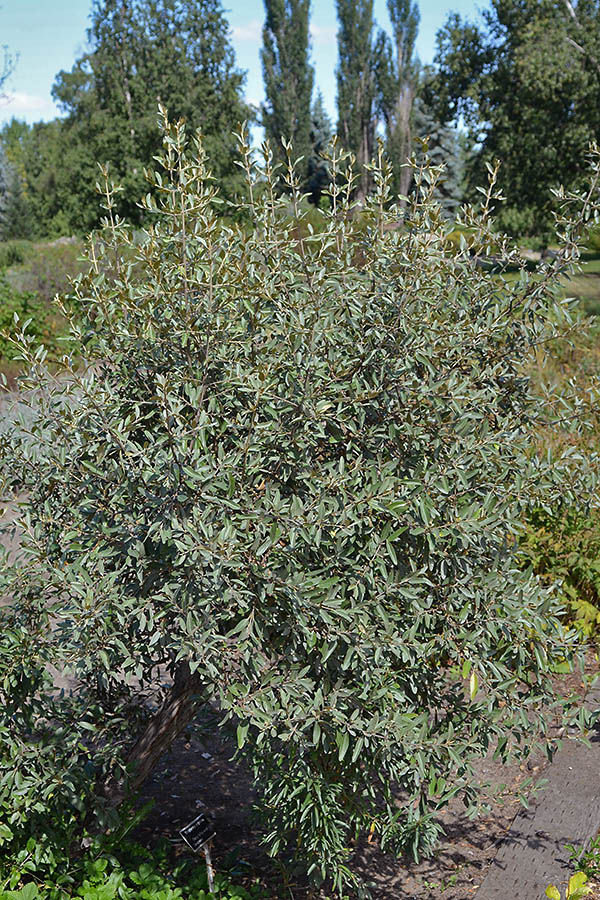
Woody > Shepherdia > Shepherdia argentea > Shepherdia argentea
Shepherdia argentea
Silver Buffaloberry
Origin: Alberta, Saskatchewan and Manitoba, Canada. North Dakota, South Dakota and Montana, United States of America.
| Family |
| Elaeagnaceae |
| Genus |
| Shepherdia |
| Species |
| argentea |
| Category |
| Woody |
| Type |
| Shrub (deciduous) |
| USDA Hardiness Zone |
| 2 - 6 |
| Canadian Hardiness Zone |
| 0a - 5b |
| RHS Hardiness Zone |
| H7 - H4 |
| Temperature (°C) |
| -46 - (-21) |
| Temperature (°F) |
| -50 - (-5) |
| Height |
| 2 - 4 m |
| Spread |
| 2 - 4 m |
Photographs
Description and Growing Information
Flowering Period
| Landscape |
| Best suited for use in a mixed border. It is typically utilized as a hedge and can be particularly useful in blocking excessive wind. This is not an overly attractive shrub, but it proves its worth as a tough plant for use next to highways and is capable of controlling erosion along embankments due to its deep roots. |
| Cultivation |
| Thrives in well-drained, moderately fertile soil with full sun. It is extremely versatile as it has been known to tolerate high winds, drought, salt, frost, partial shade and high pH levels. |
| Shape |
| Loosely-rounded crown. |
| Growth |
| Fast |
| ID Characteristic |
| The key difference between this plant and its most commonly recognized relative S. canadensis is the intense silver colour of its foliage and bark. In the summer, it can be easily identified by the round, bright red fruit on female plants. |
| Pests |
| White heart rot, leafspot, powdery mildew and rust. |
| Habitat |
| Woodlands, foothills and prairies, edges of lakes, rivers, streams and floodplains. |
| Bark/Stem Description |
| Young stems are tomentose and exhibit a silver colour. With age, bark changes to a brown colour with silver scales and begins to exfoliate in thin strips. The branches typically terminate with 2 - 5 cm long spines. The excavated pith is also brown in colour. |
| Flower/Leaf Bud Description |
| The densely pubescent buds found on this plant are around 0.6 cm in length and are loosely-scaled. They are elongated in shape, silver to silvery brown in colour and have 2, 4 or 6 scales. |
| Leaf Description |
| Simple leaves that are opposite in arrangement, have entire margins, and are oblanceolate in shape with a cuneate base and obtuse apice. They are covered in silver to silvery-brown scales and measure in at 2.5 - 5 cm in length, 0.3 - 1.6 cm wide with a 0.6 - 1.3 cm petiole. |
| Flower Description |
| Occurring in the spring, the tubular flowers on female plants are small, around 0.4 cm in diameter, apetalous, pistillate and have a calyx of 4 distinct lobes. Their colour is a dull yellow. They are situated on racemes or spikes. |
| Fruit Description |
| The fruit, only present on female plants, typically shows up in June or July either separate or in clusters. They are yellowish-red to red, one-seeded, ovoid in shape and around 0.6 cm wide. Contrary to the common name, these are not berries but rather stone fruit. This bright red fruit is sour but edible and is eaten by birds in July or August. |
| Colour Description |
| Foliage is mainly silver with a dull green undertone and its bark is brown with silvery scales. In the spring its flowers are light yellow and turn into yellowish-red to red fruit. |
| Texture Description |
| Fine texture. |
| Notable Specimens |
| The Devonian Botanic Garden, Devon, Alberta, Canada. |
| Propagation |
| Propagation by division or seed. |
| Ethnobotanical Uses (Disclaimer) |
| The fruit is used to make jelly, but can also be eaten directly off of the plant or be made into jams or pie. It has been recommended, however, that intake be limited due to the presence of a chemical known as saponin. |
